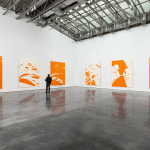Thanks to artist Brece Honeycutt, who visited the Rosemarie Trockel show at the New Museum earlier this month and has shared the following report.
—-
Occupying three floors of the New Museum, Rosemarie Trockel’s
exhibition “A Cosmos” is one of the most surreal and earthy exhibitions
currently on view in New York.
Wandering from floor to
floor and contemplating the multitude of objects on display, I wondered:
Is Trockel asking us to consider what something is–a relic, an actual
item, an artwork or a replica? Furthermore, does she ask us to
contemplate the longevity of an object on this earth, should it be used,
appropriated or discarded?
Questions abound. By titling some of her ceramic works, Made in China, is she asking us to consider by whom and where an object is made? For example, is the 27.5 pound lobster in the Perspex case real or an enlarged model? At first glance when seen from afar are the pulsating works by G�nter Weseler sea anemones? Are the glass pieces by Leopold and Rudolph Blaschka merely imaginary works or perfect renditions of jellyfish? The title of Trockel�s sculpture consisting of a cast leg clad in gray tights with pink flip flop in baroque style glass cabinet might provide a clue�Was ein Ding ist, und was es nicht ist, sind in der Form identisch, gleich�[What a thing is, and what it isn�t, are identical in form the same] (2012).
On the fourth floor Replace Me (2011) holds court amidst her ceramic pieces. Resembling a modern leather couch, with painted plastic cover and wool textile/�blanket,� the piece could comfortably sit as furniture in any contemporary loft space. However, would one abandon/replace this for the latest style? Prior to descending the stairs to the third floor the digital print Emission (2012) further begs consideration. Are the images broken pieces of plastic packing that once held something made in China and now discarded, or an inspiration for her ceramic sculptures, or soon to be an archaeological record?
At the foot of the long staircase, one sees a suite of Trockel photographs, From a French Magazine (2005) depicting a woman clad in various garments with grids and stripes. Both geometric patterns reverberate in the crisp wool lines and rows of knitting in Trockel�s textile works. These contrast with the obsessive bundling and wrapping in the sculptures made by Judith Scott. Trockel�s pieces harmonize with Scott’s, and both accentuate the patterns in the garments.
Venturing down to the second floor, one steps into a �wunder cabinet� and walks amongst Trockel�s works as well as those of other invited artists— Morton Bartlett, James Castle, Ruth Francken, Manuel Montalvo and G�nter Weseler. The art works may be contemplated one on one, for instance Ruth Francken�s Four and Seven (1969), but more importantly in context and as a whole with the other works. Two Perspex vitrines hold center stage and are filled with curious objects made by Trockel and her invitees. One cannot help but think of Damien Hirst�s glass and steel works; however, Trockel�s collaborative juxtapositions, more conceptually complex, blow them out of the water.
Around the corner, Trockel�s slide piece, Park Avenue (2006/11), flickers on the wall next to her beautifully rendered works on paper entitled Mechanical Reproduction (1995). The slides show leaves, roots, flowers arranged, singularly and in groupings. While watching the images, I wondered had Trockel walked Park Avenue and gathered cast-off plants discarded by urban gardeners? The current practice of disposable gardening�replacing viable plants seasonably, i.e. mums to poinsettias to violets—provides materials for others. Turning back to the vitrines, one sees slides scattered on the ground in her collaboration with G�nter Weseler, Living Means to Appreciate Your Mother Nude (2001).
The abundance of images and elements from the natural world abound in this exhibition: the large shell of the crab, the stuffed birds, the drawings of plants and insects by Trockel and other naturalists. The handmade objects—James Castle�s birds, Weseler�s baby, Bartlett�s dancers, Blaschka glass jellyfish, Trockel�s red ceramic piece Touchstone (2012)–resemble and echo the �real� world, but at the same time stand alone as things unto themselves.
�The only thing I can do, I think,” Trockel says, “is to try and work out my own idea of the world or of art (they are identical for me) with whatever curious things are at hand.�
“Rosemarie Trockel: A Cosmos,” New Museum, New York, NY. Through January 20, 2013.
——-
Subscribe to Two Coats of Paint by email.

























Hot Entertainment News, Bollywood Hot News, Pakistani Girls and Latest Hot Girls Pictures.
hotentertainnews.blogspot.com